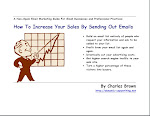Ginsu Marketing - The Art of Overwhelming Benefits
Posted by Charles Brown at Friday, October 20, 2006If you are old like me, you probably remember the Ginsu Knives commercials that came out in the 1970s and changed television advertising forever. They were funny, kitschy and a had a tongue-in-cheek tone that made them fodder for late night comedians.
Some of the phrases from these commercials were quickly adopted as part of our cultural language. Phrases like, “but wait, there’s more,” or “now what would you pay?” were inserted into everyday conversations by average (but not too bright) people.
One of the reasons these knives sold like, well... hotcakes, was the way the sellers kept throwing in more and more add ons for no extra cost.
Every time viewers thought we had seen the entire offer, the announcer would say, “but wait, there’s more.” Then a new freebie was tossed into the package.
Legend has it that the creators of the commercials were looking for an additional kitchen gadget to to add in a premium, and heard about a little gizmo that made decorative peelings out of apple and potato skins. By itself, this little peeler was so inconsequential it would have been very difficult to promote. But as a freebie, it was perfect. It could be visually demonstrated and only cost the sellers about 50 cents.
But the genius of thee commercials was how they introduced the add ons. Instead of just throwing in one new freebie after another, there was a “wrap up” each time a new add on was announced.
The announcer would summarize the entire offer as it stood so far. The voice would go back over each product, the benefits of each product and then the add on products and their benefits. After this, the voice would say, “Now what would you pay?” At this point a few possible prices, which curiously were all higher than the actual price the Ginsu folks were charging, would flash on the screen just to suggest that this was the range the viewer should be thinking of. Then when the actual price was announced as being below those suggested prices (surprise) it made the actual price seem very small.
And then, once the viewer began to assume the offer was complete, the announcer would say, “but wait, there’s more…” and throw in another freebie. The effect of throwing in all these add ons was to make the price seem ridiculously small when compared to the value received.
Now remember that each freebie cost the seller very little, but to the customer, they represented a significant value.
Can you do the same thing with what you sell? What if you threw in a free booklet, a free CD or some other add on that related to your primary offer?
Selling is all about creating a favorable return on investment (ROI) for the buyer. When all your freebies increase the value side of the offer, the price side seems to very small in comparison to what is received.
By the time a viewer had seen all that came with their Ginsu Knives for such a “low” price, they almost felt guilty for taking advantage of these dolts who were offering so much for so little.
Your aim, no matter what you are selling, is to work the ROI by increasing value every chance you can. To do this, you have to come up with your own version of, “but wait, there’s more.”
freelance copywriter, writing web content, copywriting tips, ghost writer
Labels: advertising, copywriting ideas, features vs benefits



0 comments:
Post a Comment